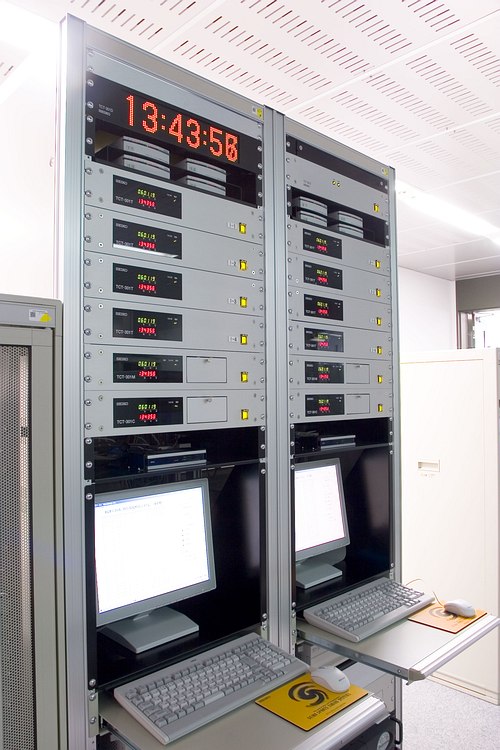Telephone JJY (no longer available)
The Telephone JJY service was terminated on March 31, 2024. The information on this page is kept for reference and historical purposes.

The telephone JJY system, nicknamed after the longwave broadcast, supplies accurate time information over a public communication line. When telephone lines were analog connections, commercially available dedicated receivers were able to synchronize with this signal with an accuracy of ± 1 ms or better, all throughout Japan. Modern alternatives for use over digital lines or the internet are Hikari Telephone JJY or network time protocol.
The time data is provided as digital information via modem, the standard method for transferring digital data over an analog communications channel. The last bit of the time data is synchronized with the one second interval of the Coordinated Universal Time (UTC) and Japan Standard Time (JST) signals provided by NICT.
Usage
In addition to dedicated receivers, any device that can communicate via modem can be used to connect to the system. Any such device will be considered a "receiver" in the following.
After the receiver initiates the connection, NICT's time data transmission system sends out the requested information in response to a range of commands.
The system uses standard communication protocols and supports configurations typically used in dial-up connection. Commonly available terminal software can then be used to communicate with the system. Please enter ID and commands as ASCII characters.
| Telephone number | 042-327-7592 |
|---|---|
| ID | TJJY |
| prompt | > |
At the prompt, you can try the HELP and INFO commands. Please use BYE or END to properly terminate the connection.
Example of operation
In the following 🛆 indicates an ASCII (half-width) space, bold text shows the the input string, and CR indicates that the enter key is pressed. ID and password are in ASCII uppercase letters, but the commands can be either upper or lower case.
After establishing a connection, the system will prompt
Press CR if this does not appear. Then enter 🛆TJJY CR
<Login message>
> TIME CR
> JST CR
> UTC CR
> DATE CR
> BYE CR
Obtaining time/date information
Commands can be entered when the prompt is displayed following the login message, shown as the single-byte ">" character. Most commands will be processed immediately. The LOOP command will establish a loopback signal within one second of the command. The UTC and JST time commands will respond according to the specified timing sequence.
If an incorrect command is entered, it will first be echoed back together with "?", followed by the prompt. If a second invalid command is entered, a message will indicate the presence of the HELP command, and the prompt will be displayed.
Delay time correction
By using the LOOP command, the time data transmission system can be configured to provide a loopback connection via a relay switch. This allows the receiver to measure the transmission delay, including the modem. COM restores the normal connection.
The image shows the communication flow between a dedicated receiver and the time data transmission system. The measured delay time includes the round-trip delay, but also the combined delays in the modem of the receiver, including modulation and demodulation itself.
If you would like to know more about measuring and correcting for the delay, please refer to 「公衆通信回線による標準時供給システム」 ("Standard time supply by public communication line") in issue 142 of the Journal of the Japanese Clock Society (1992) or contact the Japanese Clock Society at (03) 5814-5801.
When the acoustic signals are transferred over a digital communication line, the conversion and transmission introduce additional delays that are difficult to characterize. The Hikari Telephone JJY service was developed to overcome this problem. For other applications, time synchronization by NTP, the network time protocol, may be the most convenient.

